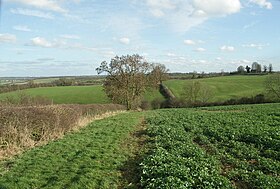Difference between revisions of "Little Oxendon"
(→History) |
m |
||
| Line 1: | Line 1: | ||
[[File:Site of Abandoned Village. - geograph.org.uk - 351872.jpg|right|thumb|280px|Site of Little Oxendon]] | [[File:Site of Abandoned Village. - geograph.org.uk - 351872.jpg|right|thumb|280px|Site of Little Oxendon]] | ||
{{county|Northamptonshire}} | {{county|Northamptonshire}} | ||
| − | '''Little Oxendon''' is a deserted | + | '''Little Oxendon''' is a deserted mediæval village in [[Northamptonshire]], about one mile north of [[Great Oxendon]] (where any population is included). The site was studied by John Bridges in his early 18th century work 'The History and Antiquities of Northamptonshire'.<ref name=b>{{cite book|editor-last=Whalley|editor-first=Peter|year=1792|title=The History and Antiquities of Northamptonshire compiled from the manuscript collections of the late learned antiquary John Bridges Esq.|volume=2|location=Oxford|pages=8–9.}}</ref> |
==Location== | ==Location== | ||
Latest revision as of 12:30, 30 January 2024
Little Oxendon is a deserted mediæval village in Northamptonshire, about one mile north of Great Oxendon (where any population is included). The site was studied by John Bridges in his early 18th century work 'The History and Antiquities of Northamptonshire'.[1]
Contents
Location
- Location map: 52°26’34"N, 0°54’57"W
- Streetmap: SP730846
History
Little Oxendon, despite its name, was historically situated in the parish of Little Bowden and not transferred to Great Oxendon until the 19th century.[2] A chapel at Little Oxendon itself was evidently built around 1398, as in that year the building was in existence but had not yet been consecrated. The chapel appears still to have been in use when Robert Palmer made his will on 10 April 1525.
In about 1467, Hugh Boyvile of Ridlington gave up the manor of Little Oxendon to his son Richard Boyville and his heirs, with remainder to William his brother and his heirs. In 1510, Richard Boyvile of Burton Latimer bequeathed his estate to his wife Gresyll for her life, after which it was to go to his son George Boyvile. A series of transactions during the early 16th century transferred the manor in sequence from George Boyvile to Andrew Palmer; his son Robert Palmer; Sir Thomas Griffin and lastly to Edward Griffin of Dingley who died about 1570.
The Royal Commission on Ancient and Historic Monuments concludes “it appears that the village was deliberately cleared for sheep farming in the 14th century”. However Little Oxendon still had at least eight inhabitants in 1405 and evidence of the total population during the 15th century is lacking, so the period suggested for depopulation may well be too early.
Bridges, shortly before his death in 1724, noted that only one house remained at Little Oxendon, though there was evidence of the site of the chapel and of several former houses as square building stones and burnt hearth stones had been dug up at different times.[1]
Outside links
- Little Oxendon footpaths: Natural England
- Aerial views (Heritage Calling): Historic England
References
- ↑ 1.0 1.1 Whalley, Peter, ed (1792). The History and Antiquities of Northamptonshire compiled from the manuscript collections of the late learned antiquary John Bridges Esq.. 2. Oxford. pp. 8–9..
- ↑ "British History Online - Great Oxendon". Institute of Historical Research. http://www.british-history.ac.uk/rchme/northants/vol3/pp158-161.
